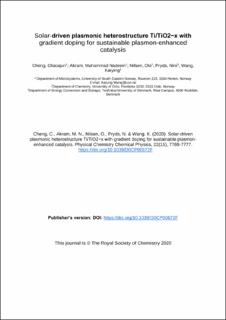Solar-driven plasmonic heterostructure Ti/TiO2−x with gradient doping for sustainable plasmon-enhanced catalysis
Journal article, Peer reviewed
Accepted version
Permanent lenke
https://hdl.handle.net/11250/2788333Utgivelsesdato
2020Metadata
Vis full innførselSamlinger
- Institutt for mikrosystemer [546]
- Publikasjoner fra CRIStin [3623]
Originalversjon
Cheng, C., Akram, M. N., Nilsen, O., Pryds, N. & Wang, K. (2020). Solar-driven plasmonic heterostructure Ti/TiO2−x with gradient doping for sustainable plasmonenhanced catalysis. Physical Chemistry Chemical Physics, 22(15), 7769-7777. https://doi.org/10.1039/d0cp00672fSammendrag
Plasmon-enhanced harvesting of photons has contributed to the photochemical conversion and storage of solar energy. However, high dependence on noble metals and weak coupling in heterostructures constrain the progress towards sustainable plasmonic enhancement. Here earth-abundant Ti is studied to achieve the plasmonic enhancement of catalytic activity in a solar-driven heterostructure Ti/TiO2−x. The heterostructure was fabricated by engineering an intense coupling of a surface-etched Ti metal and a gradient-based TiO2−x dielectric via diffusion doping. Ti/TiO2−x exhibits a highly resonant light absorption band associated with surface plasmon resonances that exhibit strong near-field enhancement (NFE) and hot electron injection effects. In a photoelectrochemical system, intense interaction of the resonant plasmons with a vicinal TiO2−x dielectric accelerates the transfer of solar energy to charge carriers for plasmon-enhanced water splitting reactions. Moreover, the plasmonic Ti/TiO2−x structure presents sustained enhanced redox activities over 100 h. The intense coupling by gradient doping offers an effective approach to enable the plasmon resonances of Ti excited by visible light. The Ti-based plasmonic heterostructure potentially opens an alternative avenue towards sustainable plasmon-enhanced catalysis.
